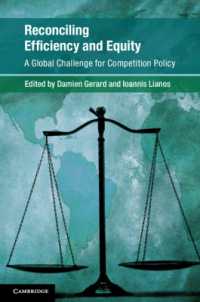Full Description
A Choice Outstanding Academic Book
In the decade since President Clinton signed the Personal Responsibility and Work Opportunity Reconciliation Act of 1996 into law-amidst promises that it would "end welfare as we know it"-did the reforms ending entitlements and moving toward time limits and work requirements lift Texas families once living on welfare out of poverty, or merely strike their names from the administrative rolls?
Under welfare reform, Texas continued with low monthly payments and demanding eligibility criteria. Many families who could receive welfare in other states do not qualify in Texas, and virtually any part-time job makes a family ineligible. In Texas, most families who leave welfare remain in or near poverty, and many are likely to return to the welfare rolls in the future.
This compelling work, which follows 179 families after leaving welfare, is set against a backdrop of multiple types of data and econometric modeling. The authors' multi-method approach draws on administrative data from nine programs serving low-income families and a statewide survey of families who have left welfare. Survey data on health problems, transportation needs, and child-care issues shed light on the patterns of employment and welfare use seen in the administrative data. In their lives after welfare, the families chronicled here experience poverty even when employed; a multiplicity of barriers to employment that work to exacerbate one another; and a failing safety net of basic human services as they attempt to sustain low-wage employment.
Contents
Preface
Acknowledgments
Chapter 1. Families in a Changing Welfare Context
Chapter 2. The Context for Texas Poverty and Welfare
Chapter 3. The Weak (and Tangled) Safety Net
Chapter 4. Making a Living After Welfare
Chapter 5. Coping with Barriers to Self-Sufficiency
Chapter 6. Staying Employed and Off Welfare
Chapter 7. Low-Income Families and TANF Policies
Appendix A: Research Methods
Appendix B: Regression Tables
Notes
Bibliography
Index








